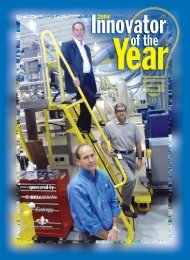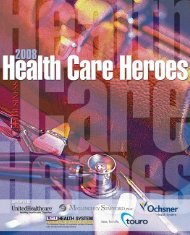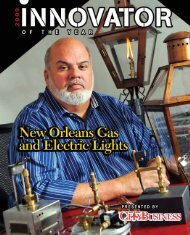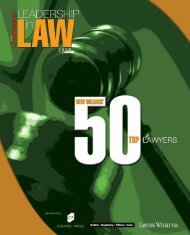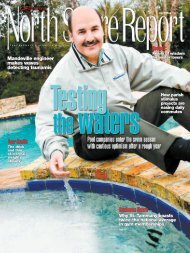INNOVATORS Gold Award - New Orleans City Business
INNOVATORS Gold Award - New Orleans City Business
INNOVATORS Gold Award - New Orleans City Business
- No tags were found...
You also want an ePaper? Increase the reach of your titles
YUMPU automatically turns print PDFs into web optimized ePapers that Google loves.
MEDICAL<br />
Deep Brain Stimulation<br />
Ochsner Health System<br />
Key innovation: a technology that sends electric pulses<br />
to pinpointed areas of the brain that cause uncontrolled<br />
movements<br />
Clients: <strong>New</strong> <strong>Orleans</strong> area patients with movement<br />
disorders<br />
Where they’re based: <strong>New</strong> <strong>Orleans</strong><br />
Top executives: Dr. Jayaraman Rao, neurosurgeon, and<br />
Dr. Roger Smith, chairman of Ochsner Health System’s<br />
neurosurgery department<br />
Year introduced: February 2008<br />
DOCTORS IN THE neurosurgery department at Ochsner<br />
Health System have grasped a technological advancement<br />
that is changing the way brain surgeons treat patients with<br />
movement disorders such as Parkinson’s disease or familial<br />
tremors.<br />
Dr. Roger Smith, chairman of the neurosurgery department<br />
at Ochsner, said he and fellow neurosurgeon Dr.<br />
Jayaraman Rao have been using Deep Brain Stimulation to<br />
send electric pulses to pinpointed areas of the brain that<br />
cause uncontrolled movements. The doctors say it is a revolutionary<br />
treatment that has changed the way neurosurgeons<br />
operate on patients with movement disorders.<br />
“In the past, surgeons who were treating diseases like<br />
Parkinson’s would have to go into the brain and damage<br />
small areas causing the movements,” Smith said. “It was<br />
once thought that freezing these parts of the brain could<br />
help patients control certain tremors, but it was not<br />
always the case.”<br />
Smith said the process comes from the same technology<br />
used for certain spinal cord injuries. He said doctors<br />
believed the technology had the potential to transfer over<br />
successfully.<br />
“At this stage of research, it is my belief that when the<br />
electrodes are placed on the brain, the stimulation does<br />
something to block the movements from happening,” Smith<br />
said. “In treatments we have done at Ochsner, patients with<br />
severe Parkinson’s tremors end up seeing a dramatic<br />
decrease in movement to where it stops almost instantly.”<br />
The new procedure enables doctors to be more precise<br />
when searching out target areas of the brain. Smith said the<br />
stimulation uses a smaller sensor to determine exactly where<br />
the electrode needs to go. He also said the procedure can be<br />
altered or reversed if changes needed to be made.<br />
“The reversibility is a stark difference from the way surgeons<br />
used to treat these diseases,” Smith said. “When<br />
doctors go in to do the damage procedure, there is no way<br />
to reverse it.”<br />
Smith said doctors at Ochsner have been using the<br />
stimulation method since February and have seen about 15<br />
patients. The procedure is not exclusive to Ochsner, however,<br />
because Rao said he had been using the technology<br />
for several years at Louisiana State University.<br />
“The technology has been around since the early ’90s,”<br />
Rao said. “It is technology that is in the early stages. So<br />
early, in fact, that we still are not quite sure how it works.<br />
We just know it works and works well.”•<br />
— Robin Shannon<br />
PHOTO BY FRANK AYMAMI<br />
Drs. Roger Smith, left, and Jayaraman Rao review a brain scan to pinpoint where they need to apply deep brain stimulation.<br />
<strong>New</strong> <strong>Orleans</strong> <strong>City</strong><strong>Business</strong> 37A




